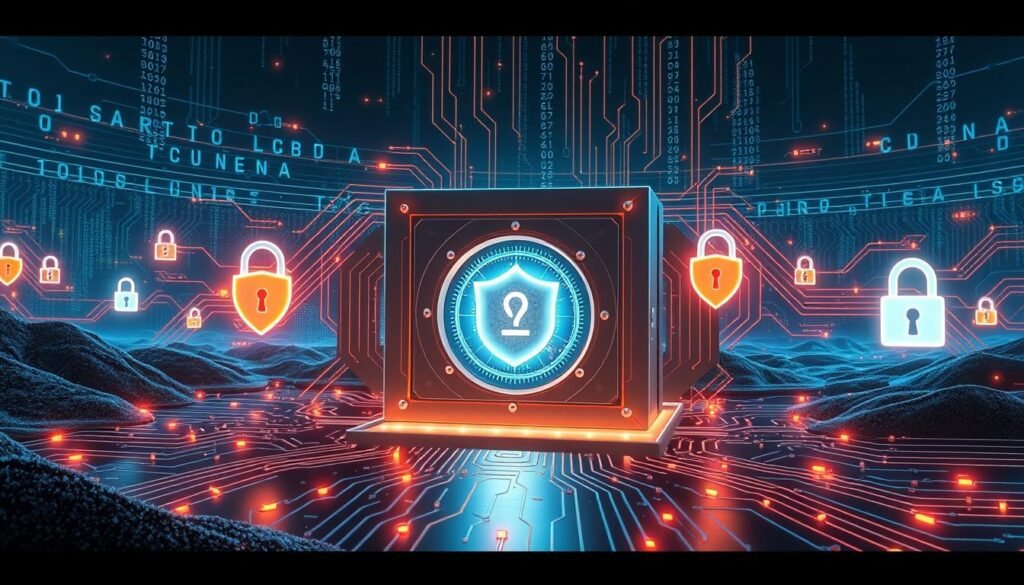Did you know that only 52% of companies do security audits? Yet, those that do have a 40% lower risk of a data breach1? It’s vital to protect your digital assets like data, customer info, and intellectual property. A detailed cyber insurance audit can spot weaknesses, strengthen security, and safeguard your digital treasures.
Key Takeaways
- Digital assets are key to your business’s worth and need protection
- Cyber insurance audits can find and lessen digital asset risks
- Regular cybersecurity checks can save your business money in the long run1
- Cybersecurity audits help meet industry rules2
- Cyber insurance adds extra protection for your digital assets
Understanding Digital Assets
In today’s digital world, businesses face a changing landscape of digital assets. These are intangible, online resources with value. They can be owned, controlled, and managed by a company3. Examples include images, digital content, social media, apps, and customer data3.
Photos, videos, website content, and social media posts are just a few examples of digital assets. They are valuable to investors and can be sold separately, adding to a company’s worth3. Businesses can also deduct expenses related to digital assets from their taxes, just like physical assets3.
What Are Digital Assets?
Digital assets are online items with legal ownership and value34. They are stored on blockchain ledgers and accessed with public and private keys4.
Types of Digital Assets
- Cryptocurrencies, such as Bitcoin and Ethereum4
- Non-fungible tokens (NFTs)4
- Digital art and collectibles4
- Virtual real estate and in-game items4
- Digital identities and personal data4
Importance of Digital Assets
Digital assets are key for businesses as they increase value and can be sold3. Companies should inventory, value, and protect these assets3. This includes using agreements, registering ownership, and keeping data safe3.
“Blockchains are the technology solutions that enable digital assets, which are stored and recorded on the blockchain ledger where they were issued4. Digital assets are typically stored with a public and private key system for access, and specific protocols generate blockchain entries4. Private keys are essential for proving ownership and transacting with digital assets, while applications can provide users with various opportunities utilizing digital tokens.”4
Protecting Your Digital Assets
Keeping your digital assets safe is key in today’s world. Start with a detailed digital asset inventory. This is a list of all your digital valuables, like images, content, and customer data5.
After you know what you own, figure out how much it’s worth. This helps you focus on protecting the most important ones5.
Limit Access and Follow Best Practices
Limiting who can access your digital stuff is a must. Use strong passwords, MFA, and keep software up to date5. Think about using hardware wallets for extra security5.
Watch out for phishing and malware. Always check if emails from banks or crypto services are real5. Use email filters and anti-phishing tools to block threats5. Also, use firewalls, encryption, and VPNs to protect your digital assets5.
Get regular security checks from experts to find and fix weak spots6. Always be ready and informed to keep your digital stuff safe5.
“Protecting your digital assets is not just a matter of technological measures, but a mindset of constant vigilance and adaptation to the evolving digital landscape.”
Legal Safeguards for Digital Assets
Protecting your digital assets is not just about technology. It also needs strong legal steps. One key step is to make people who work with you sign non-disclosure agreements (NDAs). This keeps your company’s digital secrets safe7. Also, registering your digital stuff through copyright, trademark, and patent can prove you own it7. These steps remind us to handle digital data carefully and protect our most valuable digital assets.
Use Protective Agreements
Non-disclosure agreements (NDAs) are key for keeping your digital assets safe. By making people sign these contracts, you can keep sensitive info, like trade secrets and customer data, private7. NDAs set clear rules for handling your digital stuff, lowering the chance of it getting out or being used without permission.
Register Ownership
Registering your digital stuff through copyright, trademark, and patent can also protect it. This way, you can stop others from using your digital content, software, and ideas without your say-so7. This legal shield is important if someone tries to take your digital stuff or if there’s a legal fight. It helps you prove you own it and defend it.

“Protecting digital assets is key in today’s digital world. Using legal steps like NDAs and registering ownership can add an extra layer of protection against misuse and unauthorized access.”
| Legal Safeguard | Description |
|---|---|
| Non-Disclosure Agreements (NDAs) | Legally binding contracts that prevent the disclosure of sensitive information, such as trade secrets, customer data, and proprietary processes. |
| Copyright Registration | Establishes legal ownership over digital content, such as articles, images, and software, to prevent unauthorized use or duplication. |
| Trademark Registration | Protects the branding and visual identity of your digital assets, including logos, slogans, and domain names. |
| Patent Registration | Safeguards unique digital inventions, such as innovative software or processes, by preventing others from replicating or using them without permission. |
By using these legal steps, companies can better protect their digital assets. This reduces the risk of misuse or unauthorized access7. It’s important to use both technology and law to keep digital assets safe in today’s fast-changing digital world.
Cyber Insurance Audit
The digital world is changing fast, and keeping your business safe online is key. A cyber insurance audit is a powerful tool to protect your digital assets from cyber threats8.
Benefits of Cyber Insurance Audits
Cyber insurance audits help strengthen your cybersecurity in many ways. They test your online systems and data to find and fix weaknesses8. They also check your physical security to prevent human errors that can lead to big attacks8.
These audits also test your defenses with simulated attacks. This helps lower risks for everyone involved8. They check your security systems and policies to find gaps and ensure you’re following the rules8.
Types of Cyber Insurance Audits
There are two main types of cyber insurance audits: external and internal. External audits are done by outside firms, giving a clear view of your cybersecurity8. Internal audits are done by your team, giving a closer look at your specific risks8.
Both types are important for keeping up with cyber threats and being ready for incidents8. They help find weaknesses, make sure you’re following the rules, and show you’re serious about security8.

In today’s digital world, cyber insurance audits are more important than ever. They help you find and fix vulnerabilities, keeping your digital assets safe9. Regular checks and updates are needed to keep your insurance valid and protect against new cyber risks9.
A thorough cyber insurance audit can be a big step forward for your cybersecurity. It lets you confidently protect your digital assets in the online world10.
“Cyber risk is a significant concern across all industries, requiring companies to strengthen their cyber defenses through a combination of cyber insurance, secure devices, expertise, and technology.”10
Implementing Cyber Insurance Audits
To protect your digital assets, a proactive cybersecurity audit strategy is key. Regular cybersecurity audits are vital to prepare for cyber insurance audits11. There are different types of audits, like compliance, penetration, and risk assessment audits11.
Compliance audits check if your security meets standards. Penetration audits test systems with simulated attacks. Risk assessment audits look at possible threats and their impact11.
Conduct Regular Audits
Cybersecurity audits should be done regularly to keep track of your digital security12. It’s best to do them at least once a year. But, industries with strict rules or handling sensitive data might need more12.
Businesses with personal data might audit twice a year or every quarter. PCI compliance could mean audits every 90 days or once a quarter12.
Collaborate for Security
Working together on cybersecurity can make audits more effective. It’s good to involve both your team and outside experts for a full view of your security11. External audits offer deep knowledge and independence, while internal audits are cheaper but might lack objectivity11.
It’s wise to have a team from the IT department work with auditors12.
Continuous Improvement
Improving your cybersecurity is essential. Use audit findings to update your security and plans11. Set clear goals for audits and use frameworks like COBIT and NIST CSF to find weaknesses11.
Consider the value of your data, threats, and impact to focus on the most important security areas11.

“Regular cybersecurity audits are essential for businesses to maintain cyber insurance coverage and protect their digital assets from evolving threats.”
By being proactive with your cybersecurity audit strategy, doing regular cybersecurity audits, and working together, you can better protect against cyber threats. This will also help you get good cyber insurance terms111312.
Securing Digital Assets
Keeping your digital assets safe is key in today’s world. To protect your data, follow data security best practices. This means updating your software, using two-factor authentication, and choosing secure Wi-Fi. Also, train your employees on how to stay safe online14.
Cyber insurance coverage adds extra protection. With cyber-insurance costs up 50% in a year, it’s vital to have a good policy. This can help pay for costs from data breaches and cyber attacks14.
Backup and Redundancy
Having a solid digital asset backup and redundancy plan is critical. It helps keep your business running if you’re hit by a cyber attack14. In 2024, companies faced 1,308 cyberattacks a week, up 28% from before15.
The cost of cybercrime is expected to hit $9.5 trillion in 2024, and $10.5 trillion in 202515. A strong backup and redundancy plan is more important than ever.

By using a complete plan to secure your digital assets, you can make your organization more resilient. This includes following data security best practices, getting cyber insurance, and focusing on backup and redundancy. This way, you can protect your valuable digital resources.
The Role of Cybersecurity Audits
Cybersecurity audits are key to strengthening an organization’s cyber defenses16. They find and fix weaknesses, follow rules, and fight off new cyber threats16. These audits check an organization’s IT setup, helping businesses outsmart hackers and keep their digital stuff safe.
One big plus of cybersecurity audits is spotting risks and weaknesses early1617. It’s smart to do internal checks every few months and external ones yearly to keep networks safe17. Audits should look at the whole security picture, not just parts16, for a clear view of security.
Cybersecurity audits also help meet industry rules and best practices18. For example, auditors need to know about IT systems to check for risks18. It’s also important to have auditors with the right tech skills and knowledge16.
In short, cybersecurity audits are very important1617. They help find and fix problems, making a strong cyber defense against digital threats1617.
| Key Areas of Cybersecurity Audits |
|---|
| Information Security Policies and Procedures |
| Network Security |
| Account Management |
| Access Control and Authentication |
| Vulnerability Management |
| Data Protection |
| Encryption |
Cybersecurity audits are key to keeping digital assets safe and following industry rules.
“The cybersecurity assessment should evaluate the full cybersecurity framework, not just parts.”
Assessing Vulnerabilities
Cybersecurity vulnerability assessment is key to any good cybersecurity plan. It checks networks, systems, and apps for weak spots that hackers might use19. Knowing these risks lets businesses focus on fixing them, making their security better19.
Bitsight is a tool for ongoing security checks. It watches an organization’s digital world in real-time19. Unlike old audits, Bitsight finds new threats fast, helping security stay ahead19.
Bitsight also lets companies see how they stack up against others. This helps make plans to get better without spending a lot on audits19. It explains cyber risks in simple terms, helping leaders make smart choices19.
While audits by outside groups are important, adding Bitsight’s ongoing checks gives a fuller picture of risks1920.
| Key Cybersecurity Assessment Capabilities | Description |
|---|---|
| Network Vulnerability Scanning | Identifies over 6000 vulnerabilities that hackers exploit in network servers and devices20. |
| Perimeter Device Testing | Evaluates the effectiveness of perimeter devices like firewalls, DNS, and web servers20. |
| Compliance Benchmarking | Measures security practices against industry standards like ISO and NIST, providing a scorecard for each client20. |
| Cyber Incident Cost Analysis | Analyzes the real costs of cyber incidents from an insurer’s perspective using actual reported claims20. |
Using both audits and ongoing checks helps organizations understand their risks better. They can then take steps to improve their security1920.
“Cybersecurity audits and assessments are essential for organizations to identify and address their vulnerabilities, ultimately strengthening their ability to withstand and recover from cyber threats.”
Ensuring Compliance
Keeping up with cybersecurity compliance and following data protection regulations is key. Cybersecurity audits are vital for this. They help organizations meet rules like the GDPR and UK Data Protection Act. Showing they care about data protection helps businesses gain customer trust and avoid legal trouble21.
The GDPR in Europe and the CCPA in the US push businesses to protect data22. Not following these laws can cause big fines, lawsuits, and harm to reputation22. Cyber insurance can help pay for these costs, making it easier for businesses to deal with legal issues22.
Regular cybersecurity audits are essential for staying compliant and improving security23. These audits find weak spots, check if security works, and focus on fixing risks23. How often and how deep audits are done depends on the data’s sensitivity, industry norms, and laws23.
- Big data breaches are common now, thanks to advanced cyber attacks like ransomware23.
- Fixing cybersecurity gaps can stop data breaches and keep digital assets safe23.
- Regular audits find and fix security gaps, helping to manage risks23.
Regular audits keep organizations in line with regulations, boost their security, and protect digital assets from threats23. Working with legal and cybersecurity experts can also help navigate data protection rules and best practices22.
“Cybersecurity audits are essential for businesses to assess their security posture, identify vulnerabilities, and ensure compliance with data protection regulations. By taking a proactive approach, organizations can better protect their digital assets and build trust with their customers.”
Conclusion
In today’s digital world, keeping your business’s digital assets safe is key. A detailed cyber insurance audit is vital. It helps find weak spots, makes sure you follow the rules, and fights off new cyber threats24. By being proactive, you can guard your digital stuff, keep your customers’ trust, and thrive in a changing cyber risk world.
The cyber insurance market is set to jump from $8 billion USD to $20 billion USD by 202524. This shows how important it is for managing risks. With policy prices going up and carriers needing strong security, audits are now essential for protecting your digital assets24.
By being proactive with cyber insurance audits, you can keep your digital assets safe. You’ll also meet industry standards and set your business up for success in the digital age242526. Whether you’re looking at cyber insurance audit importance or digital asset protection strategies, a good cyber insurance audit is the way to build resilience and protect your most valuable digital resources.
FAQ
What are digital assets and why are they important?
How can businesses protect their digital assets?
What are the benefits of a cyber insurance audit?
What are the different types of cyber insurance audits?
How can businesses effectively implement a cyber insurance audit strategy?
What are the key aspects of securing digital assets?
How do cybersecurity audits help organizations protect their digital assets?
What are the key benefits of conducting regular cybersecurity audits?
Source Links
- The Importance of Regular Cybersecurity Audits for Protecting Your Digital Assets – Brilliance Security Magazine – https://brilliancesecuritymagazine.com/cybersecurity/the-importance-of-regular-cybersecurity-audits-for-protecting-your-digital-assets/
- Six Benefits of a Cybersecurity Audit (and 6 Steps to Perform One) – https://www.isaca.org/resources/news-and-trends/industry-news/2024/six-benefits-of-a-cybersecurity-audit
- How to Protect Your Digital Assets in 2022 | AuditBoard – https://www.auditboard.com/blog/how-to-protect-your-digital-assets/
- Demystifying cryptocurrency and digital assets – https://www.pwc.com/us/en/tech-effect/emerging-tech/understanding-cryptocurrency-digital-assets.html
- Essential Cybersecurity Best Practices for Safeguarding Digital Assets – https://www.cm-alliance.com/cybersecurity-blog/essential-cybersecurity-best-practices-for-safeguarding-digital-assets
- Significance of Cyber Security Audit in Protecting Digital Assets | Unichrone – https://unichrone.com/blog/cybersecurity/significance-of-cyber-security-audit-in-protecting-digital-assets/
- Understanding Cyber Insurance: Safeguarding Your Digital Assets – https://www.psmpartners.com/blog/understanding-cyber-insurance-safeguarding-your-digital-assets/
- Cyber Risk Insurance Audit – https://digitpol.com/cyber-reinsurance/
- Unraveling the Risks of Cybersecurity Insurance Policies | AuditBoard – https://www.auditboard.com/blog/unraveling-the-risks-of-cybersecurity-insurance-policies/
- What Is Cyber Insurance? Why Is It Important? Risk Coverages | Fortinet – https://www.fortinet.com/resources/cyberglossary/cyber-insurance
- What is a cybersecurity audit and why is it important? – https://www.sailpoint.com/identity-library/benefits-of-a-cybersecurity-audit
- Cybersecurity Audit: The Ultimate Guide for 2024 – https://www.strongdm.com/blog/cybersecurity-audit
- Creating A Roadmap for Cyber Insurance Audit Preparedness – OculusIT – https://www.oculusit.com/blog/creating-a-roadmap-for-cyber-insurance-audit-preparedness/
- Meet Your New Cybersecurity Auditor: Your Insurer – https://www.darkreading.com/cyber-risk/meet-your-new-cybersecurity-auditor-your-insurer
- The Critical Role of Cybersecurity Audits and How to Conduct One – https://secureframe.com/blog/cybersecurity-audit
- Cybersecurity and Internal Audit – https://www2.deloitte.com/us/en/pages/risk/articles/cybersecurity-internal-audit-role.html
- The Importance of Cybersecurity Auditing: Protecting Your Data and Systems – https://www.redw.com/cybersecurity-auditing/
- The Role of Auditors in Company-Prepared Cybersecurity Information: Present and Future – https://www.thecaq.org/the-role-of-auditors-in-company-prepared-cybersecurity-information-present-and-future
- What is a Cybersecurity Audit? vs. Cyber Assessment – https://www.bitsight.com/blog/cybersecurity-audit-assessment-which-do-you-need
- QuietAudit® | Cyber Risk Scans and Assessments – https://netdiligence.com/solutions/quiet-audit/
- What Is Cyber Security Audit ? | Indusface Blog – https://www.indusface.com/blog/what-is-cyber-security-audit-and-how-it-is-helpful-for-your-business/
- The Role of Cyber Insurance in Compliance and Regulatory Requirements – https://www.nexthorizon.net/cyberinsurance-compliance-and-regulatory-requirements/
- How to Perform a Cybersecurity Audit: A 3-Step Guide | UpGuard – https://www.upguard.com/blog/how-to-perform-a-cybersecurity-audit
- The Guide to Preparing for a Cyber Insurance Audit – https://www.mobile-mentor.com/insights/guide-to-preparing-for-a-cyber-insurance-audit/
- Post-Incident Audits on Cyber Insurance Discounts – https://aronlaszka.com/papers/panda_post.pdf
- What is Cybersecurity Audit and Why is it Important? | CMIT Solutions Monmouth – https://cmitsolutions.com/redbank-nj-1154/blog/what-is-cybersecurity-audit-and-why-is-it-important/
